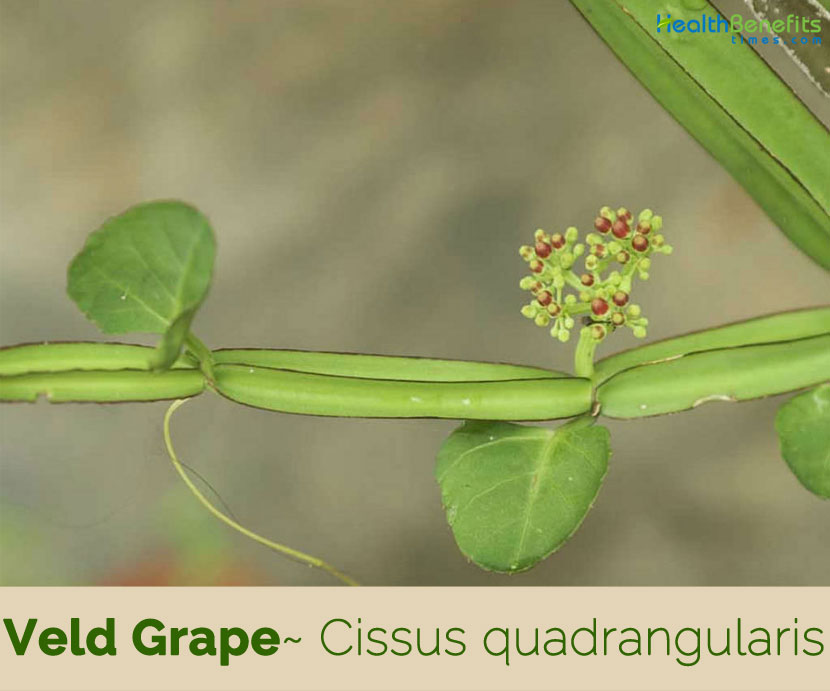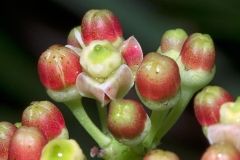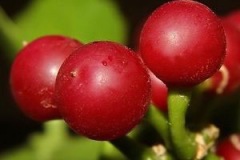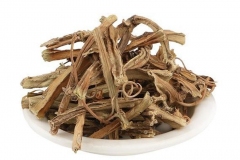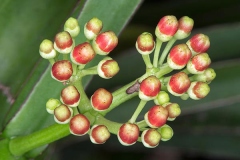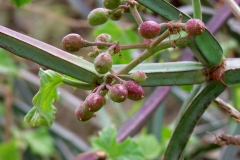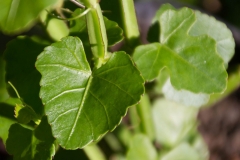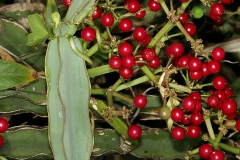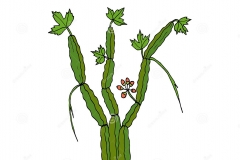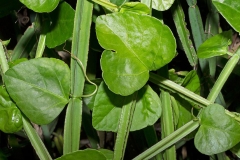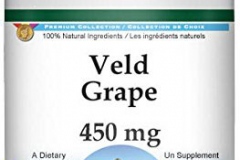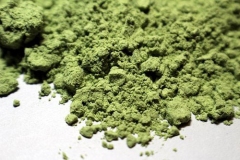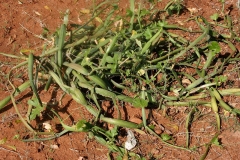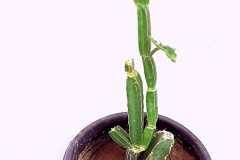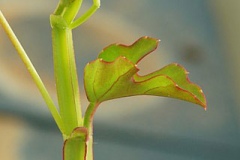| Veld Grape Quick Facts | |
|---|---|
| Name: | Veld Grape |
| Scientific Name: | Cissus quadrangularis |
| Origin | Tropical Africa, South Africa, Lesotho and Swaziland, Madagascar and the Comoros and the Arabian Peninsula |
| Colors | Green when young turning to red when ripe |
| Shapes | Ovoid to globular, succulent, very acidic, fleshy berry that are up to 12 mm in diameter |
| Taste | Acrid, Bitter |
| Health benefits | Robust Bones, Relief from Menstruation Cramps, Heart Health, Boost Immunity, Dental Care, Wound Healing, Diabetes Managements, For Digestive Health, Respiratory Disorders, Anti-Inflammatory Properties, Weight Loss, For Menopause, Bleeding Piles & Deworming, Cures Mood Swings, Fractures, Burn and scalds, Joint Pain |
| Name | Veld Grape |
|---|---|
| Scientific Name | Cissus quadrangularis |
| Native | India, but it has been distributed by man throughout the drier parts of Africa and Asia |
| Common Names | Devil’s Backbone, Adamant Creeper, Pirandai, Veldt Grape, asthisamharaka, hadjod, pirandai, Edible stemmed vine, veldt grape, Asthisanhara, Chaudhari, Chodhari, Choudhari, Hadjora, Harbhanga, Harjora, Harsankari, Hasjora, Itachovani, Kaktus manjat, Kan kaw, Kand-vel |
| Name in Other Languages | Assamese: Harjora, Harjora-lata, hara-ghunuca (হাড়-ঘুনুচা), harajoraa-lata (হাড়জোৰা লতা) Bengali: Hāṛajōṛā (হাড়জোড়া),Harbhanga, Hasjora, Hadajora English: Veldt-grape, Winged treebine, edible stemmed vine, adamant creeper, grape leaf, veld grape, devil’s backbone, Bone setter, Edible vine, square-stalked vine Finnish: Mehikissus French: Raisin de Galam, cissus de Galam, vigne de Bakel Gujrati: Hadasankala, asthisrnkhala (અસ્થિશૃંખલા), hadasankala (હાડસાંકળ) Hindi: Hadjora, Hadjod (हड़जोड़), asthibhanga (अस्थिभंग), harajora Irula: Naralai kodi Kannada: Mangaravalli (ಮಂಗರವಳ್ಳಿ), Vajravalli, Sanduballi (ಸಂದುಬಳ್ಳಿ), vajravalli (ವಜ್ರವಲ್ಲಿ) Kinyarwanda: Kiharura, Ruya, Umubogora Konkani: Sandu balli (ಸಂದ್ ಬಳ್ಳಿ) Malayalam: caṅṅalamparaṇṭa (ചങ്ങലംപരണ്ട), Changalamparanda, Peranta, Chanamparanda Marathi: Changalamparanda, Peranta, Chanamparanda, ghanasvel (घणसवेल), ghonuskande (घोणसकांडें), kandavel (कांडवेल), mhasvel (म्हसवेल) Nepali: Hadachud Oriya: Hadjodi, ହାଡ଼ଭଙ୍ଗା, ଅସ୍ଥିଭଙ୍ଗ asthibhanga, harabhanga Punjabi: Hadjjor Russian: Cissus (Циссус), Tsissus chetyrekhugol’nyy (Циссус четырехугольный) Sanskrit: Asthisamharaka (अस्थिसंहारक), Asthisandhani, Asthisamhara, Asthisamhrit, Asthisamyojaka, asthibhanga (अस्थिभङ्ग), asthisamhara (अस्थिसंहार), asthiyuj (अस्थियुज्), chaturdharin (चतुर्धारिन्), chitrakandali (चित्रकाण्डाली), kandalata (काण्डलता), siralaka (सिरालक), vajravalli (वज्रवल्लि) Shone: Murunjurunju, Muvengahonye, Renja Siddha: Piranda Sinhalese: Hirassa Swedish: Kantcissus Tamil:, Pirandai (பிரண்டை), Changalaparanda, Perandai, arukani (அருகணி), kirutti (கிருட்டி), vaccira-valli (வச்சிரவல்லி) Telegu: Nalleru (నల్లేరు), gudametige (గుడమతీగ), vajravalli (వజ్రవల్లి) Thai: Vajravalli (เพชรสังฆาต), Phet sangkhat (Phet sang kat), Phet cha sung khaat, S̄ām r̂xy t̀x (สามร้อยต่อ) Samroi to, San cha khuat Tulu: Sandu ballu (ಸಂದ್ ಬಳ್ಳು), sandu booru (ಸಂದ್ ಬೂರು) Unani: Hadjoda Urdu: Harjora هڙجوڙا, Hadsankal Vietnamese: Hồ đằng bốn cạnh |
| Plant Growth Habit | Herbaceous, deciduous, perennial succulent, deciduous shrubs or climbing plant |
| Growing Climates | Scrub, thicket, Acacia woodland, grassland with scattered trees, termite mounds, riverine thicket, coastal forest edges, sandy banks of rivers, outwash gully in dense mixed thicket |
| Soil | Prefers light sandy, loamy and clay soils and prefers well-drained soil and can grow in nutritionally poor soil |
| Plant Size | Up to 1.5 m (4.9 ft) |
| Tendrils | Long, slender and simple |
| Stem | More or less glabrous, branched, thick, succulent, and constricted at regular intervals. They are 4-angled, square in cross section, the 4 angles are prominent, narrow, often reddish and smooth |
| Leaf | Somewhat fleshy, membranous, simple, at the nodes, glabrous on both sides or sparingly pubescent. Each has a tendril emerging from the opposite side of the node |
| Flowering season | July – September |
| Flower | Small white, yellowish, or greenish. Flower-bud 2–3 mm long, glabrous |
| Fruit Shape & Size | Ovoid to globular, succulent, very acidic, up to 8-12 × 5-8 mm, glabrous |
| Fruit Color | Green when young turning to red when ripe |
| Seed | Compressed-ellipsoid, 5 mm long, 4 mm broad, smooth with single dorsal crest |
| Propagation | By Seed or stem cuttings |
| Available Forms | Powder, juice or capsule form |
| Taste | Acrid, Bitter |
| Plant Parts Used | Whole plant, stem, Aerial parts |
| Season | October – January |
| Health Benefits |
|
Plant description
Veld Grape is a herbaceous, perennial succulent, deciduous shrubs or climbing plant that normally grow about 1.5 m (4.9 ft.) tall and has quadrangular-sectioned branches with inter nodes 8–10 cm (3–4 in) long and 1.2–1.5 cm (0.5–0.6 in) wide with tuberous root stock. The plant is found growing in scrub, thicket, acacia woodland, grassland with scattered trees, termite mounds, riverine thicket, coastal forest edges, sandy banks of rivers and outwash gully in dense mixed thicket. The plant prefers light sandy, loamy and clay soils and prefers well-drained soil and can grow in nutritionally poor soil. It climbs 8–10 m over forest/jungle vegetation, or stretches in the absence of any support on the ground. In Africa it is sometimes grown near villages and also for stabilizing sand dunes. It is cultivated as a greenhouse succulent and even as a house plant.
Stem
Stem is quadrangular, almost winged, stout, succulent, glabrous, 2–8 cm long and 1–1.5 cm wide, constricted at the nodes. Tendrils are leaf-opposed and simple. Stem is almost leafless when old. Old stems are woody with grey bark. Annual rings are absent in Cissus quadrangularis.
Leaves
Leaves are somewhat fleshy, alternate, membranous and simple, at the nodes, glabrous on both sides or sparingly pubescent. Each leaf has a tendril emerging from the opposite side of the node. Petiole is polygonal in cross-section, 6-30 mm long, glabrous. Stipules are ovate-triangular, 3 – 5 mm long and 3 – 5 mm wide and deciduous. Blade is up to 3-5 cm long and 3-5(or more) cm wide, somewhat fleshy, ovate or broadly ovate, sometimes 3-lobed or deeply dissected, terminal lobe is triangular or sub-spathulate, dentate at the margin, apex obtuse, base truncate to cordate.
Flowers
Inflorescence a leaf-opposed cyme, sub-umbellate, more or less asymmetrical, (2–)4–10 cm × 5–6 cm, peduncle 1–20(–35) mm long, primary branches 2–5, one sometimes further branched, each branch few–15-flowered. Flowers are small, bisexual, 4-merous, sweetly-scented, white, yellowish, or greenish. Flower-bud is 2–3 mm long, glabrous. Calyx is 1 mm long, cup like, entire, truncate or obsurely lobed, green, 2 mm broad, glabrous. Petals are distinct, ovate-oblong, acute, hooded at apex; about 2.5 mm long recurved at anthesis, quickly caducous, pinkish inside, green and red outside. Disc is longer than the ovary. Ovary is glabrous. Style is slender up to 1–5 mm long, stigma small. Flowering normally takes place in between July and September.
Fruit
Fertile flowers are followed by an ovoid to globular, succulent, very acidic, fleshy berry that are up to 12 mm in diameter. They are 1(or two) seeded. Fruits are initially green turning to red or violet as they mature. Seeds are compressed-elliptical, 5 mm long, 4 mm broad, smooth with single dorsal crest.
Health Benefits of Veld Grape
To fully understand why this plant is so highly pursued after, let’s take a more detailed look at the many health benefits of Veld Grape
1. Robust Bones
Research has shown that that this plant helps to increases the production of osteoblasts. These are the cells that are responsible for growing bones. Taking daily supplements of Veld Grape would help prevent osteoporosis and other diseases of the bones. It also helps prevent musculo-skeletal degeneration that naturally occurs with age. It is also used to accelerate healing after fractures. Research also showed that when patients take this plant as a supplement, their bones heal faster compared to those who did not take it. This tradition, of using Veld Grape for improved bone health, originated from Ayurvedic culture centuries ago in ancient Asia. (1)
2. Relief from Menstruation Cramps
Veld Grape is quite beneficial for relieving menstrual cramps. It also helps to increase serotonin levels and helps regulate hormones. It helps relieve bloating and pain as well. This contributes to the major popularity it’s gained. Many women suffer unnecessarily every month due to menstrual cramps. This is a wonderful and natural way to ease that suffering. (2)
3. Heart Health
Veld Grape has also been directly associated to lower cholesterol levels, perhaps due to its strong impact on metabolic factors in the body. By reducing LDL or bad cholesterol in the body, Veld Grape can help protect your cardiovascular system from an excess strain, atherosclerosis, heart, attacks, strokes, and elevated blood pressure. (3)
4. Boost Immunity
High levels of ascorbic acid found in Veld Grape mean that your body gets additional defensive shield against pathogens and foreign substances in the body, as well as additional antioxidant protection. Ascorbic acid, more commonly known as vitamin C, encourages the production of white blood cells to fight infections and illness, thus improving your overall health. (4)
5. Dental Care
Veld Grape supplements helps to maintain good dental health. It helps to keep the teeth strong and healthy due to presence of abundance of calcium. More calcium equals strong and healthy teeth. Healthy teeth are more resistant to break, chip, or have cavities. (5)
6. Wound Healing
Vitamin C is also a crucial element of collagen, the material used by the body to build everything from muscle tissue to blood vessels and arteries. High levels of vitamin C help in growth and repair, meaning that wound healing can be sped up and recovery from injury and illness can be quicker. (6)
7. Diabetes Managements
Veld Grape extracts has anti-diabetes potential, which also extends to fighting against the conditions induced by diabetes. This is credited to its antioxidant content, amongst its other properties. Additionally, it is rich in quercetin. An animal research concludes that this plant is effective in improving histological, biochemical, and bio-mechanical bone changes in rats with diabetes. (7), (8)
8. For Digestive Health
Multiple researches have shown that Veld Grape restores the protective layer of mucus in the stomach. This can help prevent and heal ulcers. This was proven by numerous research performed on model lab mice. (9)
9. Respiratory Disorders
Effects of Veld Grape are sometimes similar to steroids for your system, and when it comes to the respiratory system and conditions like asthma, supplementation with Veld Grape can prevent attacks or lessen their severity. (10)
10. Anti-Inflammatory Properties
It’s been known for generations in India and Asia that this plant is effective for joint pain. Inflammation in the joints and tendons may cause discomfort. Veld Grape has natural anti-inflammatory properties that reduce general inflammation. It is even used when treating hemorrhoids. It’s been noted to have a similar effect to bio-flavonoids. Multiple researches have also confirmed its anti-inflammatory properties. (11), (12)
11. Weight Loss
Veld Grape promotes weight loss when taken along with a healthy diet. Plenty of exercises are recommended as well. It regulates hormone levels, spikes the metabolism, and suppresses appetite. This makes it easier for the body to process calories and lose weight. Increased metabolism is a great benefit for people with thyroid disorders. They generally have a very hard time losing weight. Veld Grape can also help relieve postpartum depression because of its mood enhancing elements. Women who have just given birth also have a difficult time losing weight. This plant would accelerate that process for them and give them peace of mind. (13)
12. For Menopause
Veld Grape eases the terrible effects and symptoms of menopause. It normalizes hormones, which helps with hot flashes, mood swings, and discomfort. Women over the age of fifty should supplement with this plant daily. They would sleep better, feel better, and lead happier lives. (14)
13. Bleeding Piles & Deworming
This treatment for bleeding piles has to done constantly for at least 7 to 10 days to see results. For the treatment take Veld Grape and cut into small pieces after cleaning and scrapping. Now take little bit of homemade ghee in a pan and fry the Veld Grape pieces well, till the color changes. If you don’t fry Veld Grape well, you will have the itchiness in your throat after eating it. After frying it well, grind it to a paste well in a blender, by adding very little boiled water to a paste. Store this in a bottle in the refrigerator and consume a 1/4 tsp. of this paste daily for about 10 days to get relief from anal itching, deworming and for piles. Make sure to fry the Veld Grape in ghee well, as we need to store the ground paste for almost 10 days. This treatment also gets rid of intestinal worms.
14. Cures Mood Swings
Veld Grape is a natural treatment for mood swings. When taken as a supplement, serotonin levels are increased, and disposition would generally improve. This would also improve your relationships in your personal and professional life.
15. Fractures
Stem of the plant are made into fine paste by grinding with egg albumin. This fine paste is applied over the area of fracture and bandaged. This helps to bind and heal the fractured area at the earliest. This is a very ancient bandage procedure of the folk practice.
16. Burn and scalds
Fresh leaves are taken and softened well with lime water. This juice is poured over the area of the burns and scalds immediately after the incidence. This prevents from boils and blisters.
17. Joint Pain
Stem of Veld Grape are taken and are dried. This is powdered and stored. 2-3 gram of the powder is taken along with a tsp. of honey daily. This acts as a natural calcium supplement and hence helps to fight fatigue, lethargy, aches and joint pain in forearm, legs and joints. It is also used for the treatment of Peri-menopausal syndrome.
Traditional uses and benefits of Veld Grape
- It is used in the treatment of asthma, hemorrhoids, wounds, broken bones, boils, burns, rheumatic pains, and indigestion.
- An infusion of the plant is anti-fungal and anthelmintic.
- Pulped stem is given in the treatment of asthma.
- It is used as an alternative in cases of amenorrhea.
- Leaves or young stems are analgesic and also speed the rate of healing.
- They are crushed and applied as a poultice to ease the pain of broken bones, for the maturation of boils, to cure wounds and burns, to ease the pain of rheumatic joints, and also as a treatment for saddle sores on horses.
- Powdered dry roots are used for treating indigestion.
- Powdered root is considered to be a specific in the treatment of fractured bones.
- In siddha medicine it is considered a tonic and analgesic, and is believed to help heal broken bones, thus its name asthisamharaka (that which prevents the destruction of bones).
- Assamese people and the Garo tribe of Meghalaya and Bangladesh have used Veld Grape for bone fracture.
- Young shoots are eaten as curries, also used as medicine in treatment of bone fracture.
- Stem is also supposed in Ayurveda as alterative, anthelmintic, dyspeptic, digestive, tonic, analgesic in eye and ear diseases, in the treatment of irregular menstruation and asthma, in complaints of the back and spine.
- Fibers are used in East Africa for wound dressing.
- Stems and leaves are used for skin troubles such as wounds, burns and ulcers.
- In Ayurvedic medicine it is used as an anti-inflammatory and anti-diarrheal, and against headache.
- To treat patients with fever and malaria in Senegal a decoction of the stems and leaves is rubbed into the skin and added to water for washing.
- Root infusion is used against chest pain in Northern Kenya.
- Juice from the stem is dripped into the ear against earache in East Africa.
- An infusion of the leaves is drunk as a cure for sexually transmitted diseases (STDs) in West and Central Africa.
- Decoction of the root is applied for swellings and muscle pain in South Africa.
- Juice from the stem is applied for rheumatism and to ease the pain of broken bones and hasten recovery in Java, Thailand, India and southern Africa.
- Powdered root is also used in the treatment of fractured bones, as well as for indigestion in India and Indonesia.
- Juice of the plant is applied for scurvy, asthma or nosebleed, and used as an alternative for amenorrhea.
- In Thailand, fresh stem is used in the treatment of hemorrhoids, by swallowing thin slices, covered in banana pulp, without chewing, to prevent irritation in the mouth.
- Pounded leaves mixed with oil are applied externally to inflammations and to swellings like those caused by bee stings.
- Leaf decoction is used to cure stomach-ache and diarrhea.
- Juice from the pounded leaves is drunk for cardiac problems, dizziness and fainting.
- Root strengthens the bone and treats Osteoporosis.
- It is used to reduce the excessive weight and inhibits the risk of obesity.
- It inhibits the growth of Cancer cells within the body.
- Veld Grape prevents the risk of high triglycerides to stop causing Heart Disorders. It lowers the High Blood Pressure levels.
- It maintains the blood sugar levels within the blood to prevent Diabetes.
- It provides relief from menstrual Disorders.
- It provides protection to the gums which are beneficial for treating scurvy.
- It is used to decrease the high cholesterol levels within the body.
- It is favorable in treating stomach problems.
- It relieves your throat from asthma symptoms.
- It is advisable for the patients suffering from piles.
- Young shoots of the plant are burnt to ashes in a closed vessel and administered in dyspepsia and indigestion in Madras.
- The juice of the stem is used in otorrhoea and epistaxis.
Ayurvedic Health benefits of Veld Grape
- Scanty Menses: Burn Veld Grape. Mix the ash in one teaspoon of ghee. Take three times for three days.
- Diarrhea: Take one teaspoon ash of Veld Grape with warm water two times a day.
- Obesity: Have 1/2 table spoon ash of Veld Grape with coconut water or Butter milk two times a day.
- Piles: Take one tablespoon ash of Veld Grape. Mix it in one teaspoon of ghee. Have it two times a day.
- Stomach Ache: Mix Veld Grape and Drumstick flowers in equal quantity. Add one tablespoon of dried coconut. Grind with little water. Extract the juice. Have it two times a day.
- Fracture: Mix plant juice of Veld Grape with Sesame oil. Boil it. Apply over fractured areas. OR: Consume 3 g root powder of Veld Grape. You may also apply it over fractured areas by adding some hot water in it.
- Menstrual Disorders: Grind stems and leaves of Veld Grape. Extract its juice. Add same quantity of Honey in it. Consume 20 ml of the mixture twice a day.
- Ears: Heat the stem of Veld Grape over low Flame. Extract its juice. Use it as an Ear Drop.
- Muscular Pain: Grind whole plant of Veld Grape with Turmeric rhizome. Apply this mixture over painful areas and tie with a piece of cloth.
- Asthma: Take fresh stems of Veld Grape. Grind them to make paste. Have 2 g with warm water once a day.
- Infertility: Take the juice of Veld Grape regularly.
- Piles: Consume 1 to 2 capsules of Veld Grape 500 mg two times a day for a week.
- Sexual Debility: Take one tablespoon each of Veld Grape and Nutmeg powder. Add one tablespoon ghee. Mix them. Divide in three equal parts. Have it thrice a day for a week.
- Muscular Pain: Grind Veld Grape and Fresh Turmeric rhizomes in equal quantity. Bandage to the affected area.
- Digestive Disorder: Powder 50 g dried leaves of Veld Grape to make powder. Add 25 g powder of each dried ginger and Black Pepper in it. Have 3 g twice a day.
- Throat Irritation: Fresh juice of the stem with honey for throat irritation and hoarseness of the voice.
Culinary Uses
- Leaves and young shoots are used in the preparation of curries and poppadoms.
- Fruits are eaten and the seeds are used for cooking oil.
- Ash of the plant is used as a substitute for baking powder.
- Young green stems can be consumed after being cooked.
- It is usually fried or curried.
- Young stem and leaves are made into chutney eaten as an appetizer.
- Young shoots and leaves are pleasantly acid in taste and eaten as a vegetable, often mixed with other vegetables.
- Young stems are eaten in Guinea, Sudan and Madagascar.
- In India, Sri Lanka and Malaysia the green stems are fried or curried and the ash of the plant is used as a baking powder.
- Seeds are eaten cooked in Côte d’Ivoire.
Veld Grape Dosage
Dosage of Veld Grape depends upon the formulation of whether it is being consumed in powder, juice or capsule form.
For children, a lower dosage is recommended by professional Ayurvedic practitioners, owing to their lesser body weight. Daily dosage of 1.5 grams as powder, 5 ml as the juice or 1 tablet, after meals, along with milk or ghee is recommended.
In the case of adults, an everyday dose of 3 grams of the powder, 10 – 20 ml of the juice or 2 tablets, post taking in food, with warm milk, water or ghee is considered secure.
Other facts
- It is also used as a live fence and in Somalia it is planted to stabilize dunes.
- The plant can be grown to form a hedge.
- Strong fibers are extracted from the stems in Kenya and India.
- Stem is used as a rope.
- The Turkana of northern Kenya use a root infusion as a pesticide against termites.
- The Maasai grind the stems in water and wash calves with the liquid as a fly repellent and to kill fleas.
- Pulped whole plant is applied to maggot infested wounds in Zimbabwe.
- Stem and leaf extracts have been successfully applied for the control of leaf hoppers and mites in India.
- Stems and leaves are fed to livestock and are supposed to stimulate lactation in Guinea.
- Chipped stems and ash of stems are used as fish poison in Senegal and Central Africa.
Precautions
- Few side effects include headaches, excessive gas, sleep problems, etc.
- In some sensitive people, due to its heating and drying action, it may cause such as burning sensation, restlessness, insomnia, dryness, dry mouth, sweating, etc.
- It may lower blood sugar. Stop using this at least 2 weeks before a scheduled surgery as it lowers blood sugar level.
- Person suffering from low blood sugar level should take it with caution.
- High doses may cause central nervous system depression, sedation, muscle relaxing, skin rashes or allergy.
- Paste is sharp pungent and can make scars in soft tissues on touch for the long time. So, apply carefully.
- Long term safety is unknown as no study has been done.
- Avoid use during pregnancy and breastfeeding.
References:
https://www.itis.gov/servlet/SingleRpt/SingleRpt?search_topic=TSN&search_value=897081#null
http://www.hear.org/pier/species/cissus_quadrangularis.htm
https://pfaf.org/user/Plant.aspx?LatinName=Cissus+quadrangularis
https://en.wikipedia.org/wiki/Cissus_quadrangularis
http://tn-grin.nat.tn/gringlobal/taxonomydetail.aspx?id=10622
https://npgsweb.ars-grin.gov/gringlobal/taxonomydetail.aspx?id=10622
https://en.hortipedia.com/index.php?title=Cissus_quadrangularis&mobileaction=toggle_view_desktop
http://www.llifle.com/Encyclopedia/SUCCULENTS/Family/Vitaceae/33662/Cissus_quadrangularis
https://indiabiodiversity.org/species/show/32116
http://www.theplantlist.org/tpl/record/kew-2722833
https://uses.plantnet-project.org/en/Cissus_quadrangularis_(PROTA)
https://www.planetayurveda.com/library/hadjod-cissus-quadrangularis/
http://www.catalogueoflife.org/col/details/species/id/8c7e7d13be3bd1a8df994f11cb59f1dc
https://www.monaconatureencyclopedia.com/cissus-quadrangularis-2/?lang=en
https://plants.usda.gov/java/ClassificationServlet?source=display&classid=CIQU5
https://www.flowersofindia.net/catalog/slides/Veldt%20Grape.html


